Pangio semicincta
'Kuhli' Loach
SynonymsTop ↑
Acanthophthalmus semicinctus Fraser-Brunner, 1940; Acanthophthalmus kuhlii sumatranus Fraser-Brunner, 1940
Etymology
semicincta: from the Latin semi, meaning ‘half’, and cinctus, meaning ‘belt, girdle’, reference to the colour pattern of this species.
Classification
Order: Cypriniformes Family: Cobitidae
Distribution
Currently accepted to occur in Peninsular Malaysia plus the Great Sunda Islands of Sumatra and Borneo but the true extent of its distribution is unclear.
Type locality is given as Malay Peninsula (Malacca, Johore) which corresponds to what’s now normally referred to as Mawai district collected in Johor state at the southern tip of Peninsular Malaysia, but similar-looking fish have been recorded from numerous localities across the above range.
Colour pattern is variable both within and between populations and the species will probably turn out to represent a complex of closely-related taxa with at least 3 genetic lineages already identified (Bohlen et al. 2011, also see ‘Notes’ below).
Fraser-Brunner (1940) described populations from southern Sumatra as a subspecies, Acanthophthalmus kuhlii sumatranus, but these are currently considered synonymous with P. semicincta (Tan and Kottelat, 2009).
Habitat
Most commonly found in shallow, slow-moving sections of forest streams or other calm habitats such as swamps, oxbows, and backwaters.
Many such environments are associated with ancient peat swamps and contain black water although it’s also found in clear waters which may or may not be tannin-stained to some extent.
Such habitats are typically shaded from the sun by marginal vegetation and the dense tree canopy above.
The water generally has a negligible dissolved mineral content, is poorly buffered and pH can be as low as 3.0 or 4.0 due to the gradual release of tannins and organic acids from decaying plant material.
Depending on locality the substrate may be composed of peat, mud or sand with the fish typically abundant in piles of leaf litter.
In the Rajang river basin, Sarawak state, Malaysian Borneo sympatric species include Cyclocheilichthys apogon, C. repasson, Garra borneensis, Osteochilus hasseltii, Paracrossochilus vittatus, Rasbora argyrotaenia, R. dusonensis, R. kottelati, R. sarawakensis, ‘Puntius‘ johorensis, ‘P.‘ kuchingensis, ‘P.‘ pentazona, Sundadanio margarition, Trigonopoma pauciperforatum, Pangio anguillaris, P. piperata, Syncrossus hymenophysa, several Gastromyzon, Homaloptera and Nemacheilus spp., Betta akarensis, Sphaerichthys osphromenoides and Carinotetraodon salivator.
Maximum Standard Length
90 – 100 mm.
Aquarium SizeTop ↑
An aquarium with base measurements of at least 60 ∗ 30 cm or equivalent is recommended.
Maintenance
Use a soft, sandy substrate since this species likes to dig and tends to spend some of its time completely buried. When coarser gravel is used it may become stressed or damage itself, and feeding behaviour can be inhibited.
A few driftwood roots and branches, placed in such a way that plenty of shady spots are formed, can be used to add structure to the display and addition of dried leaf litter would provide additional cover and aid in simulating natural conditions.
Fairly dim lighting is also preferable with aquatic plants from genera such as Microsorum, Taxiphyllum, and Cryptocoryne suitable.
Gentle filtration providing a little surface agitation is adequate and high flow rates best avoided.
Ensure that small specimens are unable to enter filter intakes and cover the tank well as most loaches do jump at times, especially when introduced to a new environment.
Water Conditions
Temperature: 21 – 26 °C
pH: 3.5 – 7.0
Hardness: 0 – 143 ppm
Diet
Chiefly a micropredator sifting mouthfuls of substrate through the mouth and gills from which insect larvae, small crustaceans and suchlike are extracted with a proportion of the natural diet also likely to comprise organic detritus and plant material from the gut contents of prey.
In the aquarium it will accept sinking dried foods but should also be offered regular meals of live and frozen Daphnia, Artemia, bloodworm, micro worm, grindal worm, etc.
Behaviour and CompatibilityTop ↑
Pangio spp. are peaceful both with one another and other fishes and there exist no reports of them harming tankmates though they may prey on eggs or fry.
In nature they’re often found in large aggregations and in captivity will often pack themselves into a single nook, cranny or cave when at rest, so a group of at least 5-6 specimens should be the minimum purchased.
Small, peaceful species from similar environments such as Boraras, Sundadanio, smaller Rasbora, Trichopsis, Sphaerichthys, Kottelatlimia, etc., constitute the best tankmates.
Some sand-dwelling loaches from the family Nemacheilidae are also suitable but proper research is essential as some can be excessively competitive, territorial or otherwise aggressive.
Sexual Dimorphism
Adult females are typically heavier-bodied and a little larger then males, while in mature males the first pectoral-fin ray is branched and thickened.
Reproduction
Several vague reports exist but none are supported by solid information or photographs.
Presumably a seasonal spawner in nature.
NotesTop ↑
This species is among the most frequently-misidentified in the hobby, almost always being traded as P. kuhlii.
However the latter is currently considered endemic to Java, from where commercial collections are almost unheard of, and has possibly never been seen in aquaria.
In fact the relationship between these two has long been confused and remains so to a certain extent. For example, P. semicincta was regarded valid from 1940 until 1992 when it was placed in synonomy with P. kuhlii by Burridge.
Later Kottelat and Lim (1993) pointed out a lack of adequate evidence in Burridge’s work but conditionally agreed with her in considering the two synonymous since they could detect no significant differences between her Javanese neotype, Malaysian specimens and their series from southern Sumatra.
They concluded by suggesting that more work be done to ascertain if the pair, along with the nominal subspecies P. k. sumatrana, represent the same species or not.
In a 1995 article published in German aquarist magazine Datz, Kottelat reported he had received fresh P. kuhlii material from Java and confirmed P. semicincta to be a separate taxa. Kottelat & Widjanarti (2005) stated that ‘recent material obtained from Java has shown that the two species are distinct’.
In 2009 Tan and Kottelat confirmed that ‘Fresh material from Java shows that the two species have very distinctive colour patterns’.
They also examined specimens collected from the Musi river drainage in southern Sumatra, close to the type locality of P. sumatrana, and found no discernible differences between them and other Sumatran populations of P. semicincta.
P. sumatrana was thus adjudged to be synonymous with P. semicincta rather than P. kuhlii, with the former occurring in Peninsular Malaysia, Sumatra and Borneo and latter endemic to Java.
As far as aquarists are concerned the situation is still confused, since fresh Javanese material has not been described in detail anywhere we know of, meaning we don’t know what characters diagnose P. kuhlii sensu stricto. A single colour image appears in Kottelat (2012).
It also seems likely that a number of unidentified, similar-looking populations exist, particularly on Borneo, of which some have undoubtedly appeared in the aquarium trade.
However even if further study reveals P. kuhlii to occur outside Java it appears probable that it is not the common aquarium ‘Kuhli/coolie’ loach which is more likely to be P. semicincta, one or more unidentified species, or a combination of these.
P. semicincta is included in the P. kuhlii–oblonga group of closely-related species within the genus as per Bohlen et al. (2011).
Unfortunately a contemporary diagnosis of its distinguishing characters is lacking due to the issues surrounding its validity discussed above, and the following are therefore selected from Fraser-Brunner (1940): depth of body contained about 8 times and length of head 6½ times in standard length; 3 pairs of barbels of which the rostral pair are longest; dorsal fin II, 6; anal fin II, 6; pectoral-fin I, 10; colour yellowish with a series of broad transverse bands mostly confined to upper half of body and usually wider above than below; basal half of caudal-fin with asymmetrical black patch.
Its colopur pattern is highly irregular with innumerable variations, both within and between populations, though most specimens exhibit the same basic pattern of dark saddle-like markings, usually wider at the dorsal surface, over a yellow/orange base colour.
Although Fraser-Brunner states the ‘saddles’ are usually restricted to the upper half of the body there exist many forms in which they extend well below the lateral line. The saddles also break up to a certain extent in some older individuals which can result in some peculiar patterning.
Kottelat and Lim (1993) suggested that the P. kuhlii and P. oblonga species groups represent two of four such assemblages within the genus alongside the P. anguillaris and P. shelfordii groups.
Members were separated from those of the P. kuhlii, P. shelfordii and P. anguillaris groups by their plain body patterning, 8-9 pectoral–fin rays, 45-51 vertebrae and development of adipose keels on both ventral and dorsal extremes of the caudal peduncle.
This unofficial system was followed until Bohlen et al. (2011) published a molecular phylogenetic analysis including 18 recognised species plus a number of undescribed ones.
Their results suggest the existence of three, rather than four, major lineages within the genus; the P. anguillaris and P. shelfordii groups represent two of them with Kottelat and Lim’s P. kuhlii and P. oblonga groups together forming the third.
Within this third lineage are three sublineages formed by P. filinaris, an apparently undescribed fish from the Temburong River in Brunei referred to as P. cf. oblonga IV, and all other species in the group, respectively.
Species in the P. khulii and P. oblonga groups had previously been separated largely on the basis of colour pattern, i.e., barred vs. plain brown, but in the molecular analysis the barred species grouped within the brown. They also display a high degree of morphological affinity with simlarities in body shape and the number of vertebrae.
One brown specimen even grouped together with the barred P. malayana collected from the same locality rather than any of the other plain fish, suggesting a degree of phenotypic variability within species may also be involved.
Pangio is among the most speciose cobitid genera and widespread throughout South and Southeast Asia with species diversity thought to be considerably greater than currently recognised.
Pangio species are often generically referred to as ‘kuhli’ or ‘coolie’ loaches in the aquarium hobby, the latter a variation of the former which was itself derived from the surname of German naturalist Heinrich Kuhl (1797-1821). Ichthyologists tend to refer to them as ‘eel loaches’.
They’re distinguished from other cobitids by their long, slender body shape, relatively high number of vertebrae and the position of the dorsal-fin which is situated well behind the origin of the pelvic fins (vs. in front of, above or only slightly behind).
Several described members were previously included in the genus Acanthophthalmus which Kottelat (1987) demonstrated to be a syonym of Cobitis, and he chose the replacement name Pangio in preference to its simultaneous synonym Apua (Blyth, 1860).
Myers (1929) placed P. anguillaris as type species of Cobitophis, a grouping containing the very elongate species, while Perugia (1892) originally described P. doriae in the genus Eucirrhichthys. The former was synonymised with Acanthophthalmus by Nalbant (1963) and the latter by Roberts (1989).
The family Cobitidae, often referred to as ‘true’ loaches, is widely-distributed across most of Eurasia with the Indian subcontinent, Southeast Asia and China representing particular centres of species diversity.
Phylogenetic analyses by Tang et al. (2006), Šlechtová et al. (2007) and Šlechtová et al. (2008) revealed that the group constitutes a separate genetic lineage to the family Botiidae (the two were previously grouped together under Cobitidae as subfamilies Cobitinae and Botiinae).
In the most recent study Pangio was found to be more closely affiliated with Acantopsis, Acanthopsoides and Kottelatlimia than Lepidocephalichthys as had been previously hypothesised.
All cobitids possess sharp, motile, sub-ocular spines which are normally concealed within a pouch of skin but erected when an individual is stressed, e.g. if removed from the water. Care is therefore necessary as these can become entangled in aquarium nets and with larger species even break human skin.
References
- Fraser-Brunner, A., 1940 - Annals and Magazine of Natural History, Series 11 v. 6 (32): 170-175
On some fishes of the genus Acanthophthalmus, with description of a new species. - Bohlen, J., V, Šlechtová, H. H. Tan and R. Britz, 2011 - Molecular Phylogenetics and Evolution 61(3): 854-865
Phylogeny of the Southeast Asian freshwater fish genus Pangio (Cypriniformes; Cobitidae). - Britz, R. and J. Maclaine, 2007 - Ichthyological Exploration of Freshwaters 18(1): 17-30
A review of the eel-loaches, genus Pangio, from Myanmar (Teleostei: Cypriniformes: Cobitidae). - Britz, R. and M. Kottelat, 2010 - Ichthyological Exploration of Freshwaters 20(4): 317-376
Pangio longimanus, a miniature species of eel-loach from central Laos (Teleostei: Cypriniformes: Cobitidae). - Burridge, M. E., 1992 - Copeia 1992(1): 172-186
Systematics of the Acanthophthalmus kuhlii complex (Teleostei: Cobitidae), with the description of a new species from Sarawak and Brunei. - Hadiaty, R. K. and M. Kottelat, 2009 - Zootaxa 2171: 65-68
Pangio lidi, a new species of loach from eastern Borneo, Indonesia. - Kottelat, M., 2012 - Raffles Bulletin of Zoology Supplement 26: 1-199
Conspectus cobitidum: an inventory of the loaches of the world (Teleostei: Cypriniformes: Cobitoidei). - Kottelat, M. 1995 - DATZ Aquarien-Terrarien 48: 304-309
Malaiische Halbinsel und Indonesien: Die Dornaugen der Gattung Pangio. - Kottelat, M. and E. Widjanarti, 2005 - The Raffles Bulletin of Zoology Supplement 13: 139-173
The fishes of Danau Sentarum National Park and the Kapuas Lakes area, Kalimantan Barat, Indonesia. - Kottelat, M. and K. K. P. Lim, 1993 - Raffles Bulletin of Zoology 41(2): 203-249
A review of the eel-loaches of the genus Pangio (Teleostei: Cobitidae) from the Malay Peninsula, with descriptions of six new species. - Tan, H. H. and M. Kottelat, 2009 - Ichthyological Exploration of Freshwaters 20(1): 13-69
The fishes of the Batang Hari drainage, Sumatra, with description of six new species. - Tang, Q., H. Liu, R. Mayden and B. Xiong, 2006 - Molecular Phylogenetics and Evolution 39(2): 347-357
Comparison of evolutionary rates in the mitochondrial DNA cytochrome b gene and control region and their implications for phylogeny of the Cobitoidea (Teleostei: Cypriniformes). - Šlechtová, V., J. Bohlen and A. Perdices, 2008 - Molecular Phylogenetics and Evolution 47(2): 812-831
Molecular phylogeny of the freshwater fish family Cobitidae (Cypriniformes: Teleostei): delimitation of genera, mitochondrial introgression and evolution of sexual dimorphism. - Šlechtová, V., J. Bohlen and H. H. Tan, 2007 - Molecular Phylogenetics and Evolution 44(3): 1358-1365
Families of Cobitoidea (Teleostei; Cypriniformes) as revealed from nuclear genetic data and the position of the mysterious genera Barbucca, Psilorhynchus, Serpenticobitis and Vaillantella.
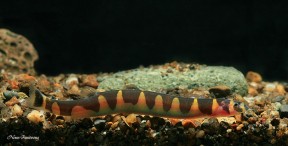
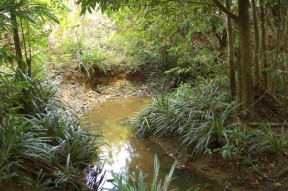




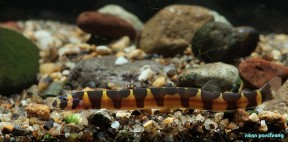
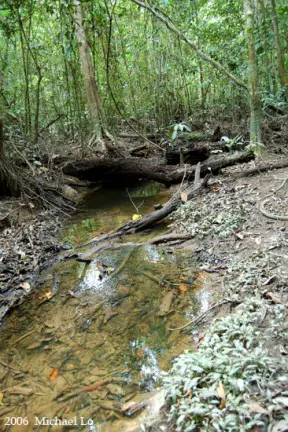
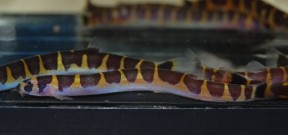
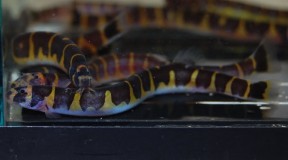



April 29th, 2016 at 10:37 pm
About 12 years ago one of my pangio semicincta spawned. If I remember correctly Ph was around 8,5 watertemp around 25 C. Hundreds of tiny mint green coloured eggs could be seen on the bottom of my tank near a favourite hiding spot. None of the eggs hatched. The female died shortly thereafter. Before spawning the eggs where slightly visible through her skin, both sides looked somewhat ‘inflated’. I took pictures and I’ll try an find them. They weren’t of the best quality.
December 9th, 2017 at 4:08 pm
I also had a tank containing mostly Kuhlis that spawned regularly back in the mid-80s. It was a 10 gallon tank with an undergravel filter, and after buying a half dozen and keeping them for a few years, I noticed little ones about an inch long appearing. I never saw any eggs, but I know the adults occasionally would get caught in the lift tubes (only one ended up dying), and I always assumed a couple made it under the filters. They were my favorite fish to interact with. They would launch themselves up over plants, and drift down so they could hang in the branches. Then, they would look around. Once the initial shyness was gone, they were very active and friendly.